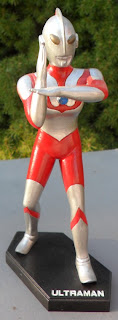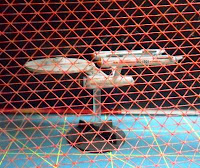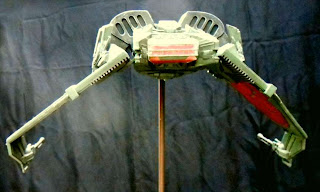I've been wanting to open a second blog, the first being
Bellerophon's Scale Modeling Blog.
So here it is. There are features on Blogger I really like that aren't supported by blog.com (namely any widget that uses scripts). What'll I do with two blogs? Either put my main posts here, with the overflow on the other (like extra pictures), or divide up posts according to content. Or else keep one and let the other wither.
So here's some pictures of my Bandai Ultraman model, done up with aluminum and engine red enamels. I've also got an unbuilt Baltan Seijin (the lobster monster), which will have to accompany Ultraman at some unspecified future date.
 |
| Ultraman, right profile. | | | | |
|
I took the above photo back in June with a new Samsung PL20. I don't think I had discovered the macro feature yet, or the features governing autofocus, so he's not looking as sharp as he might.
Below are two photos I took yesterday, having gotten a bit more experience with this camera. In addition to finding out how to use the shooting features, I also discovered some of the compromises Samsung made in designing a $100 camera. These don't make much difference for sort of pictures people mostly take, but they do show up in model photographs. One problem: you can't control compression, so the image looks colorized, but by someone who couldn't color inside the lines. The CCD has some misbehaving pixels, too, which show up as random spots of color, usually faint and spread out due to compression. But the first function of a model photograph is documentary, and it is possible to take a reasonably good documentary photo a model with this camera.
I also resampled and compressed the photos with Corel Photo-Paint 12. The resampling cut the number of pixels to one-sixteenth, and I don't see that any real image data was lost. The camera boasts 14 megapixels, but it seems 13 million of them are just recording the same thing as their neighbors, plus noise.
 |
| Ultraman, front |
 |
| Ultraman, left three-quarters view. |





















